2013 California Standards for Accessible Design Pocket Guide
DIVISION 8: SPECIAL ROOMS, SPACES AND ELEMENTS
11B-801.1 Scope.
The provisions of Division 8 shall apply where required by Division 2 or where referenced by a requirement in this chapter.
[2010 ADAS] Advisory 801.1 Scope. Facilities covered by these requirements are also subject to the requirements of the other chapters. For example, 806 addresses guest rooms in transient lodging facilities while 902 contains the technical specifications for dining surfaces. If a transient lodging facility contains a restaurant, the restaurant must comply with requirements in other chapters such as those applicable to certain dining surfaces.
11B-802 Wheelchair spaces, companion seats, and designated aisle seats and semi-ambulant seats
[2010 ADAS] 802 Wheelchair Spaces, Companion Seats, and Designated Aisle Seats
11B-802.1 Wheelchair spaces.
Wheelchair spaces shall comply with Section 11B-802.1.
11B-802.1.1 Floor or ground surface.
The floor or ground surface of wheelchair spaces shall comply with Section 11B-302. Changes in level are not permitted.
Exception: Slopes not steeper than 1:48 shall be permitted.
11B-802.1.2 Width.
A single wheelchair space shall be 36 inches (914 mm) wide minimum. Where two adjacent wheelchair spaces are provided, each wheelchair space shall be 33 inches (838 mm) wide minimum.

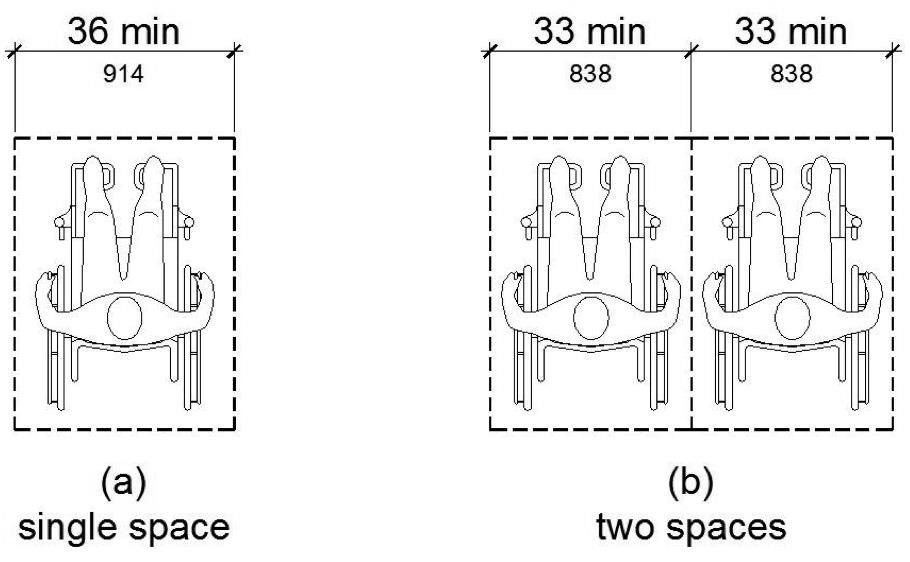
WIDTH OF WHEELCHAIR SPACES
11B-802.1.3 Depth.
Where a wheelchair space can be entered from the front or rear, the wheelchair space shall be 48 inches (1219 mm) deep minimum. Where a wheelchair space can be entered only from the side, the wheelchair space shall be 60 inches (1524 mm) deep minimum.

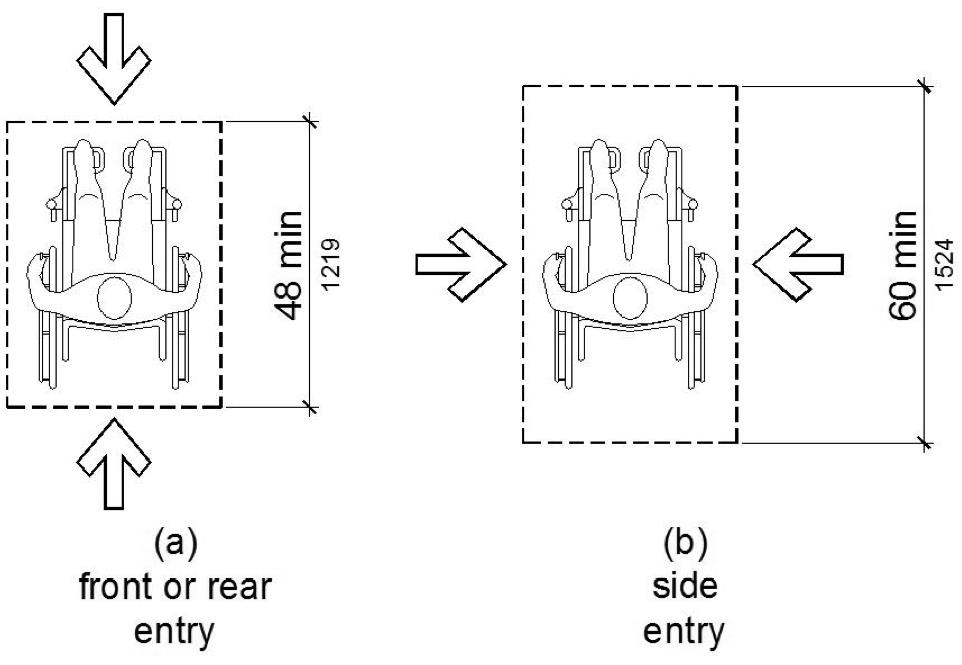
DEPTH OF WHEELCHAIR SPACES
11B-802.1.4 Approach.
Wheelchair spaces shall adjoin accessible routes. Accessible routes shall not overlap wheelchair spaces.
11B-802.1.5 Overlap.
Wheelchair spaces shall not overlap circulation paths.
11B-802.2 Lines of sight.
Lines of sight to the screen, performance area, or playing field for spectators in wheelchair spaces shall comply with Section 11B-802.2.
11B-802.2.1 Lines of sight over seated spectators.
Where spectators are expected to remain seated during events, spectators in wheelchair spaces shall be afforded lines of sight complying with Section 11B-802.2.1.
11B-802.2.1.1 Lines of sight over heads.
Where spectators are provided lines of sight over the heads of spectators seated in the first row in front of their seats, spectators seated in wheelchair spaces shall be afforded lines of sight over the heads of seated spectators in the first row in front of wheelchair spaces.
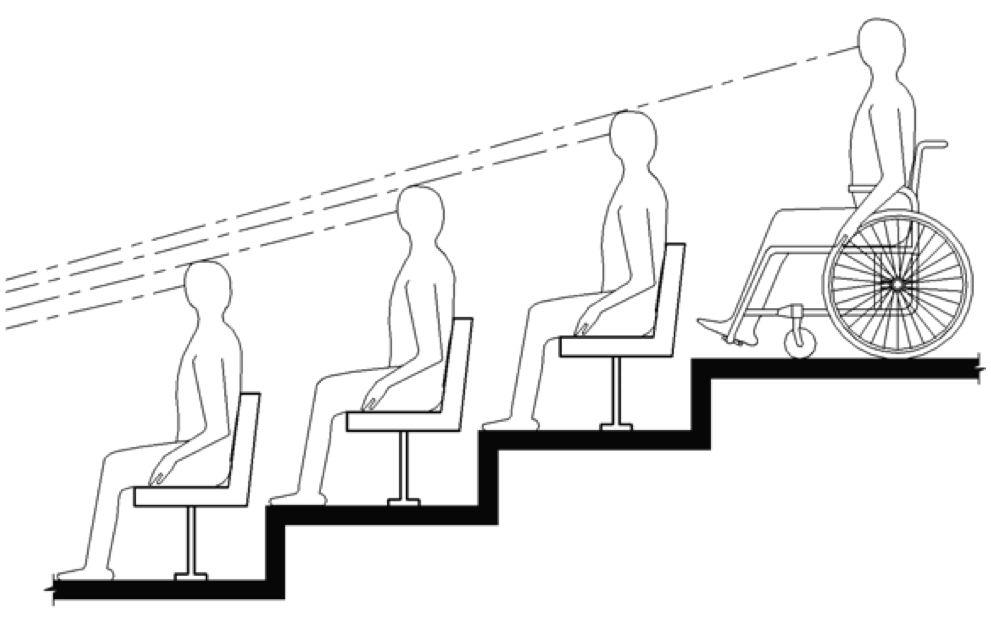
LINES OF SIGHT OVER THE HEADS OF SEATED SPECTATORS
11B-802.2.1.2 Lines of sight between heads.
Where spectators are provided lines of sight over the shoulders and between the heads of spectators seated in the first row in front of their seats, spectators seated in wheelchair spaces shall be afforded lines of sight over the shoulders and between the heads of seated spectators in the first row in front of wheelchair spaces.
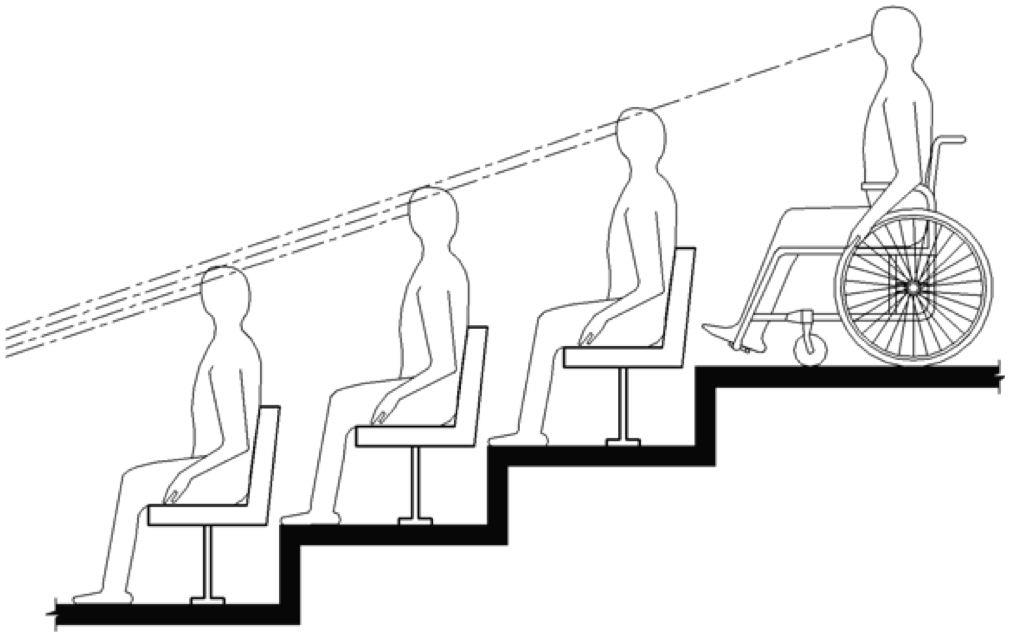
LINES OF SIGHT BETWEEN THE HEADS OF SEATED SPECTATORS
11B-802.2.2 Lines of sight over standing spectators.
Where spectators are expected to stand during events, spectators in wheelchair spaces shall be afforded lines of sight complying with Section 11B-802.2.2.
11B-802.2.2.1 Lines of sight over heads.
Where standing spectators are provided lines of sight over the heads of spectators standing in the first row in front of their seats, spectators seated in wheelchair spaces shall be afforded lines of sight over the heads of standing spectators in the first row in front of wheelchair spaces.
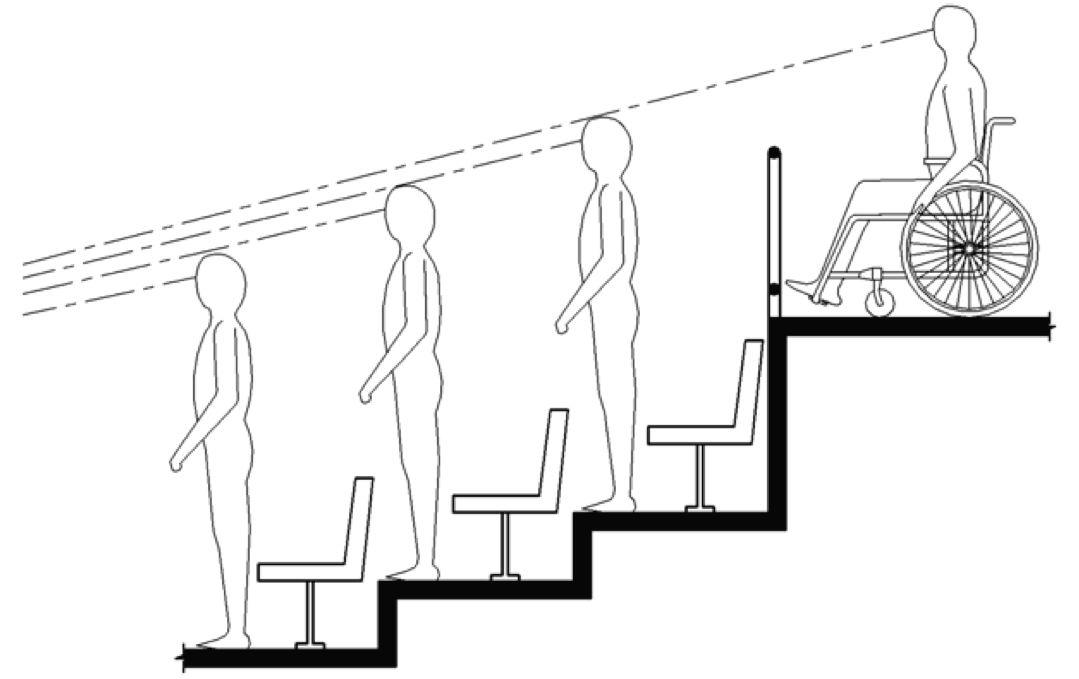
LINES OF SIGHT OVER THE HEADS OF STANDING SPECTATORS
11B-802.2.2.2 Lines of sight between heads.
Where standing spectators are provided lines of sight over the shoulders and between the heads of spectators standing in the first row in front of their seats, spectators seated in wheelchair spaces shall be afforded lines of sight over the shoulders and between the heads of standing spectators in the first row in front of wheelchair spaces.
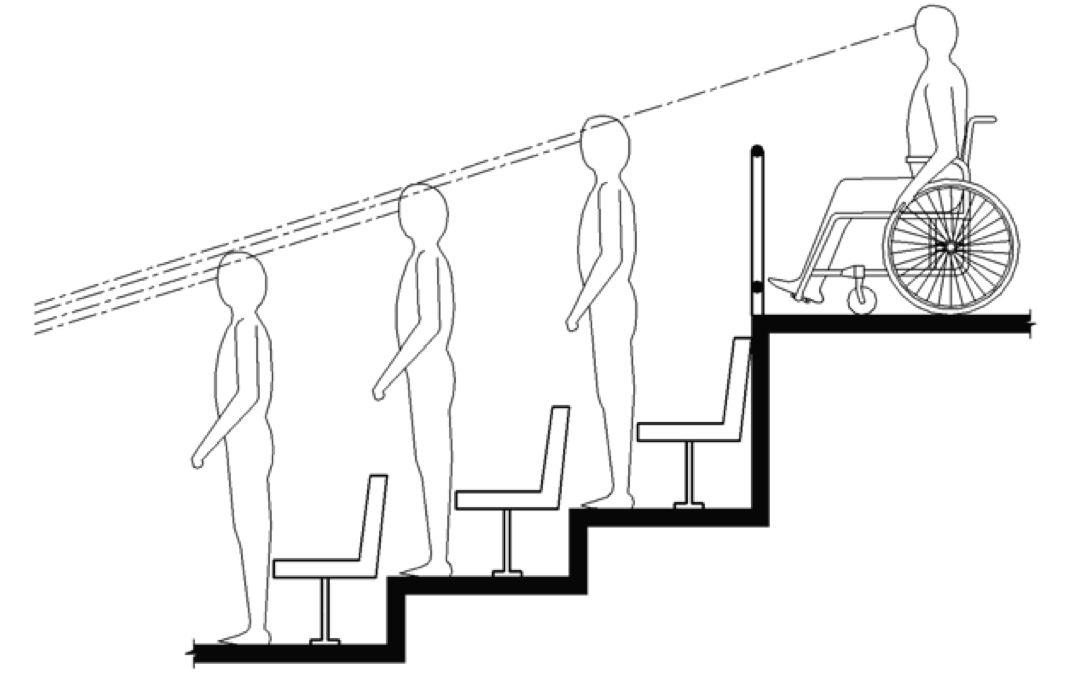
LINES OF SIGHT BETWEEN THE HEADS OF STANDING SPECTATORS
11B-802.3 Companion seats.
Companion seats shall comply with Section 11B-802.3.
11B-802.3.1 Alignment.
In row seating, companion seats shall be located to provide shoulder alignment with adjacent wheelchair spaces. The shoulder alignment point of the wheelchair space shall be measured 36 inches (914 mm) from the front of the wheelchair space. The floor surface of the companion seat shall be at the same elevation as the floor surface of the wheelchair space.
11B-802.3.2 Type.
Companion seats shall be equivalent in size, quality, comfort, and amenities to the seating in the immediate area. Companion seats shall be permitted to be movable.
11B-802.4 Designated aisle seats.
Designated aisle seats shall comply with Section 11B-802.4.
11B-802.4.1 Armrests.
Where armrests are provided on the seating in the immediate area, folding or retractable armrests shall be provided on the aisle side of the seat.
11B-802.4.2 Identification.
Each designated aisle seat shall be identified by a sign or marker with the International Symbol of Accessibility complying with Section 11B-703.7.2.1. Signage complying with Section 11B-703.5, notifying patrons of the availability of such seats shall be posted at the ticket office.
[2010 ADAS] 802.4.2 Identification. Each designated aisle seat shall be identified by a sign or marker.

11B-802.5 Semi-ambulant seats.
Semi-ambulant seats shall provide at least 24 inches (610 mm) clear leg space between the front of the seat to the nearest obstruction or to the back of the seat immediately in front.
11B-803.1 General.
Dressing, fitting, and locker rooms shall comply with Section 11B-803.
11B-803.2 Turning space.
Turning space complying with Section 11B-304 shall be provided within the room.
11B-803.3 Door swing.
Doors shall not swing into the room unless a turning space complying with Section 11B-305.3 is provided beyond the arc of the door swing.
11B-803.4 Benches.
A bench complying with Section 11B-903 shall be provided within the room.
11B-803.5 Coat hooks and shelves .
Coat hooks provided within the room shall be located within one of the reach ranges specified in Section 11B-308. Shelves shall be 40 inches (1016 mm) minimum and 48 inches (1219 mm) maximum above the finish floor or ground. Coat hooks shall not be located above the bench or other seating in the room.
[2010 ADAS] 803.5 Coat Hooks and Shelves. Coat hooks provided within the room shall be located within one of the reach ranges specified in 308. Shelves shall be 40 inches (1015 mm) minimum and 48 inches (1220 mm) maximum above the finish floor or ground.
11B-803.6 Mirrors.
Mirrors shall be installed with the bottom edge of the reflecting surface 20 inches (508 mm) maximum above the finish floor or ground. Mirrors shall be full length with a reflective surface 18 inches (457 mm) wide minimum by 54 inches (1372 mm) high minimum and shall be mounted in a position affording a view to a person on the bench as well as to a person in a standing position.
11B-804.1 General.
Kitchens, kitchenettes, and wet bars shall comply with Section 11B-804.
11B-804.2 Clearance.
Where a pass through kitchen is provided, clearances shall comply with Section 11B-804.2.1. Where a U-shaped kitchen is provided, clearances shall comply with Section 11B-804.2.2.
Exception: Spaces that do not provide a cooktop or conventional range shall not be required to comply with Section 11B-804.2.
11B-804.2.1 Pass through kitchen.
In pass through kitchens where counters, appliances or cabinets are on two opposing sides, or where counters, appliances or cabinets are opposite a parallel wall, clearance between all opposing base cabinets, counter tops, appliances, or walls within kitchen work areas shall be 40 inches (1016 mm) minimum. Pass through kitchens shall have two entries.
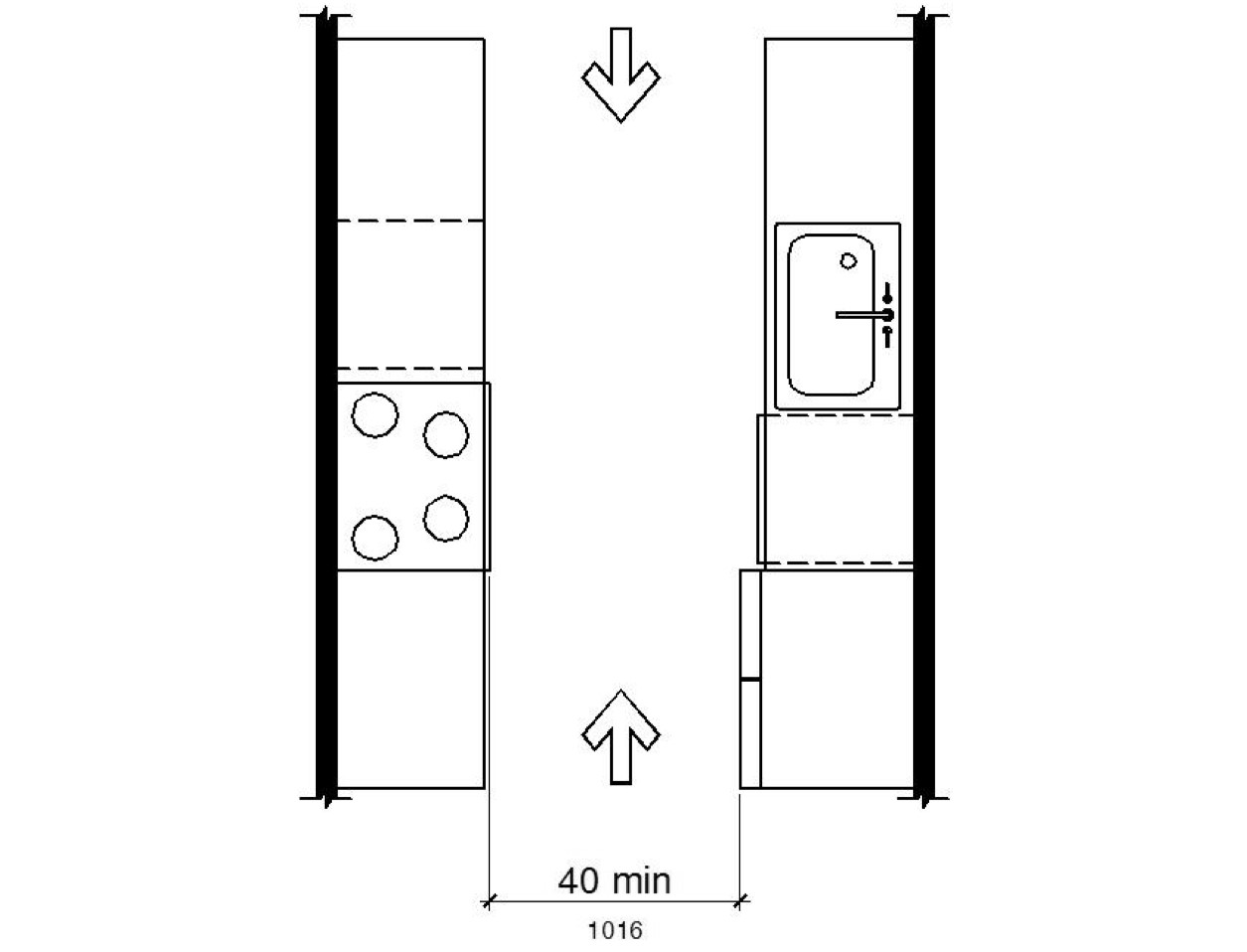
PASS THROUGH KITCHENS
11B-804.2.2 U-Shaped.
In U-shaped kitchens enclosed on three contiguous sides, clearance between all opposing base cabinets, counter tops, appliances, or walls within kitchen work areas shall be 60 inches (1524 mm) minimum.
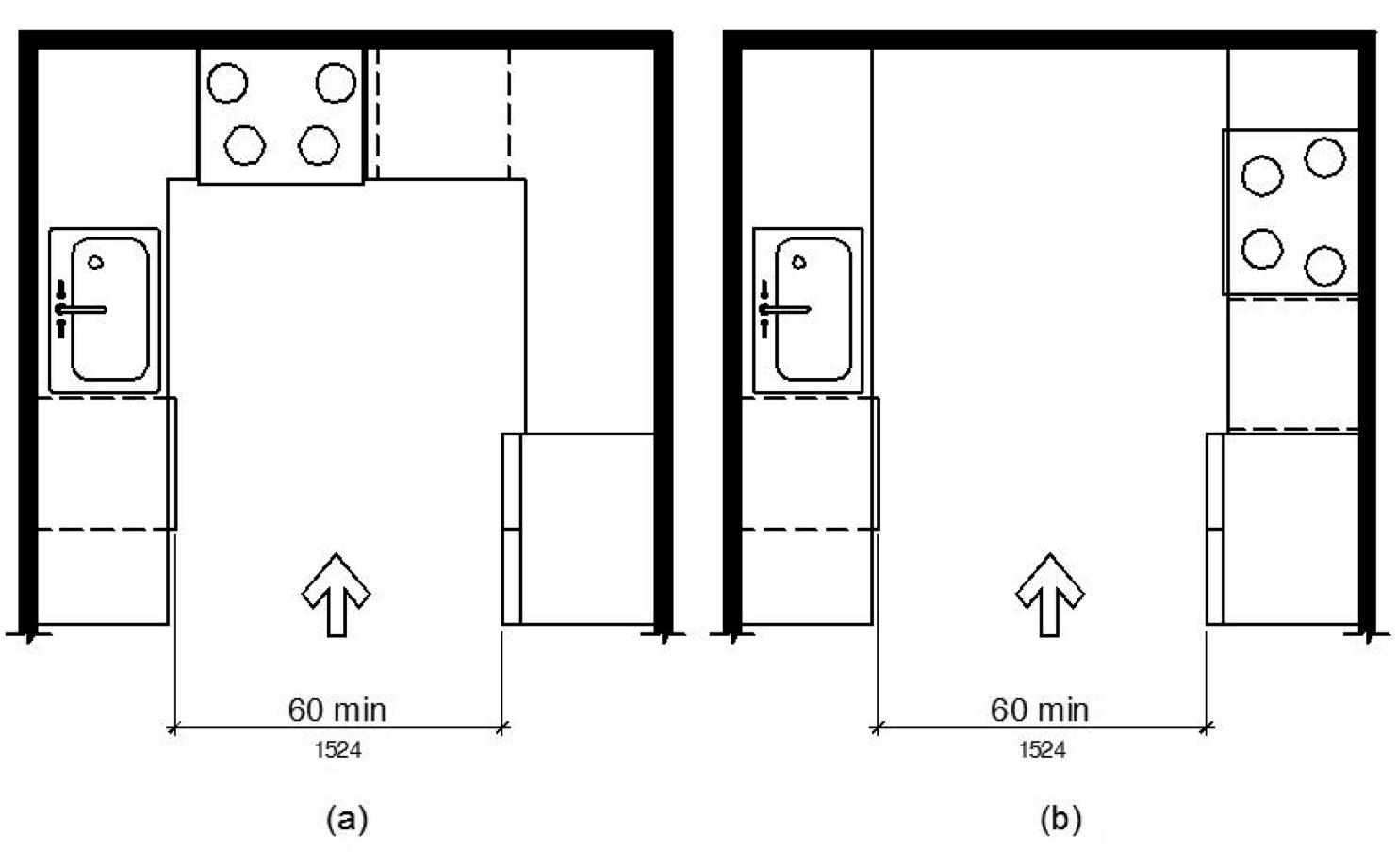
U-SHAPED KITCHENS
11B-804.3 Kitchen work surface.
In residential dwelling units required to comply with Section 11B-809, at least one 30 inches (762 mm) wide minimum section of counter shall provide a kitchen work surface that complies with Section 11B-804.3.
11B-804.3.1 Clear floor or ground space.
A clear floor space complying with Section 11B-305 positioned for a forward approach shall be provided. The clear floor or ground space shall be centered on the kitchen work surface and shall provide knee and toe clearance complying with Section 11B-306.
Exception: Cabinetry shall be permitted under the kitchen work surface provided that all of the following conditions are met:
(a) the cabinetry can be removed without removal or replacement of the kitchen work surface;
(b) the finish floor extends under the cabinetry; and
(c) the walls behind and surrounding the cabinetry are finished.
11B-804.3.2 Height.
The kitchen work surface shall be 34 inches (864 mm) maximum above the finish floor or ground.
Exception: A counter that is adjustable to provide a kitchen work surface at variable heights, 29 inches (737 mm) minimum and 36 inches (914 mm) maximum, shall be permitted.
11B-804.3.3 Exposed surfaces.
There shall be no sharp or abrasive surfaces under the work surface counters.
11B-804.5 Storage.
At least 50 percent of shelf space in storage facilities shall comply with Section 11B-811.
11B-804.6 Appliances.
Where provided, kitchen appliances shall comply with Section 11B-804.6.
11B-804.6.1 Clear floor or ground space.
A clear floor or ground space complying with Section 11B-305 shall be provided at each kitchen appliance. Clear floor or ground spaces shall be permitted to overlap.
11B-804.6.2 Operable parts.
All appliance controls shall comply with Section 11B-309.
Exceptions:
1. Appliance doors and door latching devices shall not be required to comply with Section 11B-309.4.
2. Bottom-hinged appliance doors, when in the open position, shall not be required to comply with Section 11B-309.3.
11B-804.6.3 Dishwasher.
Clear floor or ground space shall be positioned adjacent to the dishwasher door. The dishwasher door, in the open position, shall not obstruct the clear floor or ground space for the dishwasher or the sink.
11B-804.6.4 Range or cooktop .
Where a forward approach is provided, the clear floor or ground space shall provide knee and toe clearance complying with Section 11B-306. Where knee and toe space is provided, the underside of the range or cooktop shall be insulated or otherwise configured to prevent burns, abrasions, or electrical shock. The location of controls shall not require reaching across burners.
11B-804.6.5 Oven.
Ovens shall comply with Section 11B-804.6.5.
11B-804.6.5.1 Side-hinged door ovens.
Side-hinged door ovens shall have the work surface required by Section 11B-804.3 positioned adjacent to the latch side of the oven door.
11B-804.6.5.2 Bottom-hinged door ovens .
Bottom-hinged door ovens shall have the work surface required by Section 11B-804.3 positioned adjacent to one side of the door.
11B-804.6.5.3 Controls.
Ovens shall have controls on front panels.
11B-804.6.6 Refrigerator/freezer.
Combination refrigerators and freezers shall have at least 50 percent of the freezer space 54 inches (1372 mm) maximum above the finish floor or ground. The clear floor or ground space shall be positioned for a parallel approach to the space dedicated to a refrigerator/freezer with the centerline of the clear floor or ground space offset 24 inches (610 mm) maximum from the centerline of the dedicated space.
11B-805 Medical care and long-term care facilities
ETA Editor's Note
The numbering of subsections within Section 11B-805 is not aligned between 2013 CBC and 2010 ADAS. The 2013 CBC requirements are considerably more extensive, as indicated by the italicized requirements below.
11B-805.1 General.
Medical care facilities and long-term care facilities shall comply with Section 11B-805. All common use spaces and public use spaces in medical care facilities and long-term care facilities shall comply with this chapter.
[2010 ADAS] 805.1 General. Medical care facility and long-term care facility patient or resident sleeping rooms required to provide mobility features shall comply with 805.
11B-805.2 Patient bedrooms and resident sleeping rooms.
Patient bedrooms and resident sleeping rooms required to provide mobility features shall comply with Section 11B-805.2.
ETA Editor's Note
According to the Office of Statewide Health Planning and Development (OSHPD), "resident sleeping rooms," not defined in 2013 CBC Chapter 2, refers to the bedrooms of long-term care occupants. The scoping for accessibility of On-Call Rooms for physicians and other staff is addressed at Subsection 11B-223.2.3, and these are treated as Transient Lodging components.
11B-805.2.1 Hand washing fixtures.
Hand washing fixtures shall comply with Section 11B-606.
11B-805.2.2 Beds.
A 36 inch (914 mm) minimum wide clear space shall be provided along the full length of each side of the beds.
[2010 ADAS] 805.3 Clear Floor or Ground Space. A clear floor space complying with 305 shall be provided on each side of the bed. The clear floor space shall be positioned for parallel approach to the side of the bed.
11B-805.2.3 Turning space.
Turning space complying with Section 11B-304 shall be provided within the room.
11B-805.2.4 Toilet and bathing rooms.
Toilet and bathing rooms that are provided as part of patient bedrooms and resident sleeping rooms complying with Section 11B-223.2 or 11B-223.3 shall comply with Section 11B-603. Where provided, one water closet, one lavatory, and one bathtub or shower shall comply with the applicable requirements of Sections 11B-603 through 11B-610.
[2010 ADAS] 805.4 Toilet and Bathing Rooms. Toilet and bathing rooms that are provided as part of a patient or resident sleeping room shall comply with 603. Where provided, no fewer than one water closet, one lavatory, and one bathtub or shower shall comply with the applicable requirements of 603 through 610.
11B-805.3 Waiting rooms.
Waiting rooms shall comply with Section 11B-805.3.
11B-805.3.1 Wheelchair spaces.
Where seating is provided in waiting rooms, at least 5 percent of the seating shall be wheelchair spaces complying with Section 11B-802.1.
Exception: In waiting rooms serving facilities specializing in treating conditions that affect mobility, 10 percent of the seating shall be wheelchair spaces complying with Section 11B-802.1.
11B-805.4 Examination, diagnostic and treatment rooms.
Examination, diagnostic and treatment rooms shall comply with Section 11B-805.4.
ETA Editor's Note
The Office of Statewide Health Planning and Development (OSHPD), which has jurisdiction over hospitals and long-term care facilities in California, has issued Code Application Notice CAN 2-11B, dated 9/9/14, which includes the following interpretation of Section 11B-805.4:
Examination, diagnostic and treatment rooms refer to all patient care areas and include but are not limited to: exam rooms, treatment rooms, imaging rooms, operating rooms, emergency rooms, post anesthesia recovery rooms/units, dialysis rooms/units, infusion rooms/units, labor/delivery/recovery rooms and observation rooms/units. All examination, diagnostic and treatment rooms shall be accessible. Toilet rooms that are accessed from an examination, diagnostic or treatment room shall also be accessible. Note that all patient toilet rooms, other than those specifically exempted (i.e. non-accessible patient rooms and ICU patient rooms), must comply with Section 11B-603.
This is a scoping requirement, apparently misplaced outside Division 2.
11B-805.4.1 Beds, exam tables, procedure tables, gurneys and lounge chairs.
A 36 inch (914 mm) minimum wide clear space shall be provided along the full length of each side of beds, exam tables, procedure tables, gurneys and lounge chairs.
Exception: General exam rooms in non-emergency settings may provide clear space on only one side of beds, gurneys and exam tables.
11B-805.4.2 Equipment.
Clear space complying with Section 11B-305.2 shall be provided as required for specific equipment.
11B-805.4.3 Turning space.
Turning space complying with Section 11B-304 shall be provided within the room.
ETA Editor's Note
The Office of Statewide Health Planning and Development (OSHPD), which has jurisdiction over hospitals and long-term care facilities in California, has issued Code Application Notice CAN 2-11B, dated 9/9/14, which includes the following interpretation of Subsections 11B-805.4.1, 11B-805.4.2 and 11B-805.4.3:
All patient care areas must provide access to the area and to the bed, exam table, procedure table, gurney, lounge chair and/or equipment/apparatus associated with the delivery of care, exam, diagnosis or treatment performed in the space. Access includes compliance with Division 4 of Chapter 11B for travel to, and circulation within, the patient care area; and turning space in compliance with Section 11B-304. A minimum of a 36-inch wide access shall be provided to and along each side of the bed, exam table, procedure table, gurney, lounge chair and/or equipment/apparatus. "Each side" includes both sides and the foot, but does not include the head unless the provision of care requires it. Refer to the following examples:
Exam room - Exam rooms are required to provide a turning space, accessible handwashing fixture, and 36-inch wide access along the full length of each side and the foot of the exam table. The exception is in reference to general exam rooms only. These are restricted to those meeting the definition of exam room in CBC Section 1224.3. Specific exam rooms required to be larger than 80 square feet are not considered "general exam rooms" and are not eligible for the exception.
Treatment room - Treatment rooms are required to provide a turning space, accessible handwashing fixture, accessible counter and writing surface, and 36-inch wide access along the full length of each side and foot of the treatment table. If the treatment room is intended to accommodate procedures requiring access to the head (e.g. minor surgery, etc.), all four sides of the table require 36-inch wide access.
Equipment - Exam or treatment rooms with equipment such as imaging must provide a turning space, accessible handwashing fixture if required, and 36-inch wide access to both sides and the foot of the table. The head of the equipment does not require 36-inch access if only used for servicing.
OSHPD has not yet made it clear which, if any, movable items are allowed within the required 36-inch wide access.
11B-805.5 Patient Change Areas.
Areas where patients change or are prepared for a procedure shall comply with Section 11B-222.
11B-805.6 Hand washing fixtures, lavatories and sinks.
All hand washing fixtures, lavatories and sinks shall comply with Section 11B-606.
Exception: Scrub sinks, as defined in California Plumbing Code Section 221.0, shall not be required to comply with Section 11B-606.
ETA Editor's Note
The Office of Statewide Health Planning and Development (OSHPD), which has jurisdiction over hospitals and long-term care facilities in California, has issued Code Application Notice CAN 2-11B, dated 9/9/14, which includes the following interpretation of Section 11B-805.6:
The requirements of Section 11B-606 apply to all lavatories, sinks, and handwashing fixtures for public use, patient use, and employee use, unless otherwise specifically exempted by the code. Lavatories, sinks, and handwashing fixtures are common use areas and therefore, require accessibility.
Exceptions:
• Scrub sinks (due to impracticality)
• Specific workstations (see Section 11B-203.9). This applies only where the sink is the actual workstation.
Example: A sink used exclusively for cleaning endoscopes. The sink is the actual area where work is performed as opposed to a place where the employee cleans up before and after performing work elsewhere in the room.
Knee clearance requirement - All accessibility requirements of Section 11B-606 apply to lavatories, sinks and handwashing fixtures required to be accessible. Lavatories are subject to Section 11B-306.3.3, Exception 1 which states: "At lavatories required to be accessible by Section 11B-213.3.4, the knee clearance shall be 27 inches (686 mm) high minimum above the finish floor or ground at a depth of 8 inches (203 mm) minimum increasing to 29 inches (737 mm) high minimum above the finish floor or ground at the front edge of a counter with a built-in lavatory or at the front edge of a wall-mounted lavatory fixture."
This requirement applies to all lavatories. "Handwashing fixtures" are special application "sinks" and not subject to the exception. Handwashing fixtures, as sinks, are subject to Section 11B-306.2.3, Exception 1 which states" "The toe clearance shall extend 19 inches minimum under sinks required to be accessible by Section 11B-212.3."
Consequently, handwashing fixtures must have a minimum depth of 19 inches in order to comply with the minimum toe clearance. They shall also have a minimum knee clearance of 27 inches at the depth and reduction described in Sections 11B-306.3.3 and 11B-306.3.4.
The implications of this interpretation are that a wall-mounted china fixture of the most common size, nominally 20 inches wide x 18 inch projection, cannot serve as a handwashing fixture. See also the ETA Editor's Note at 11B-212.3.
11B-805.7 Built-in cabinets and work surfaces.
Built-in cabinets, counters and work surfaces shall be accessible, including: patient wardrobes, nurse’s stations, administrative centers, reception desks, medicine preparation areas, laboratory work stations, equipment consoles, clean and soiled utility cabinets, and storage areas; and shall comply with Sections 11B-225 _|Storage|_ and 11B-902 _|Dining Surfaces and Work Surfaces|_.
ETA Editor's Note
The Office of Statewide Health Planning and Development (OSHPD), which has jurisdiction over hospitals and long-term care facilities in California, has issued Code Application Notice CAN 2-11B, dated 9/9/14, which includes the following interpretation of Section 11B-805.7:
Built-in equipment consoles include recessed or wall mounted Electronic Medical Record (EMR) systems. These units must also comply with US Access Board Section 508 Standards for Electronic and Information Technology. A 30-inch by 48-inch clear floor space, in compliance with Section 11B-305, shall be centered in front of the display screen. Wall-mounted units shall comply with protrusion limits prescribed in Section 11B-307.2. Touch screen units shall be allowed to be vertically mounted with the centerline of the display screen no more than 52 inches above the floor in compliance with Section 11B-707.7.1.1. These units will need the capability of an alternate input method such as a wireless keyboard made available to those who would need it.
Exceptions:
1. Built-in wardrobes in patient bedrooms and resident sleeping rooms not required to be accessible are not required to comply with the provisions of this chapter.
2. Clinical laboratory work stations provided in a laboratory area that are in addition to the minimum number required to be accessible (5 percent of the work stations provided, but no fewer than one), are not required to comply with the provisions of Section 11B-902.
11B-806.1 General.
Transient lodging guest rooms shall comply with Section 11B-806. Guest rooms required to provide mobility features shall comply with Section 11B-806.2. Guest rooms required to provide communication features shall comply with Section 11B-806.3.
11B-806.2 Guest rooms with mobility features.
Guest rooms required to provide mobility features shall comply with Section 11B-806.2.
11B-806.2.1 Living and dining areas.
Living and dining areas shall be accessible.
11B-806.2.2 Exterior spaces.
Exterior spaces, including patios, terraces and balconies that serve the guest room shall be accessible.
11B-806.2.3 Sleeping areas.
At least one sleeping area shall provide a 36 inch (914 mm) by 48 inch (1219 mm) minimum clear space on both sides of a bed. The clear space shall be positioned for parallel approach to the side of the bed.
[2010 ADAS] 806.2.3 Sleeping Areas. At least one sleeping area shall provide a clear floor space complying with 305 on both sides of a bed. The clear floor space shall be positioned for parallel approach to the side of the bed.
Exception: Where a single clear floor space complying with Section 11B-305 positioned for parallel approach is provided between two beds, a clear floor or ground space shall not be required on both sides of a bed.
11B-806.2.3.1 Personal lift device floor space.
There shall be a clear space under the bed for the use of a personal lift device. The clear space shall extend under the bed parallel to the long side and be adjacent to an accessible route. The clear space shall extend to points horizontally 30 inches (762 mm), vertically 7 inches (178 mm) and not more than 12 inches (305 mm) from the head and foot end of the bed.
ETA Editor's Note
The clearance prescribed for a personal lift device at 2013 CBC 11B-806.2.3.1 is not required by 2010 ADAS.
11B-806.2.4 Toilet and bathing facilities.
At least one bathroom that is provided as part of a guest room shall comply with Section 11B-603. No fewer than one water closet, one lavatory, and one bathtub or shower shall comply with applicable requirements of Sections 11B-603 through 11B-610. In addition, required roll-in shower compartments shall comply with Section 11B-608.2.2 or 11B-608.2.3. Toilet and bathing fixtures required to comply with Sections 11B-603 through 11B-610 shall be permitted to be located in more than one toilet or bathing area, provided that travel between fixtures does not require travel between other parts of the guest room.
11B-806.2.4.1 Vanity counter top space.
If vanity counter top space is provided in non-accessible guest toilet or bathing rooms, comparable vanity counter top space, in terms of size and proximity to the lavatory, shall also be provided in accessible guest toilet or bathing rooms.
[2010 ADAS] Advisory 806.2.4.1 Vanity Counter Top Space. This provision is intended to ensure that accessible guest rooms are provided with comparable vanity counter top space.
11B-806.2.5 Kitchens, kitchenettes and wet bars.
Kitchens, kitchenettes and wet bars shall comply with Section 11B-804.
[2010 ADAS] 806.2.5 Kitchens and Kitchenettes. Kitchens and kitchenettes shall comply with 804.
11B-806.2.6 Turning space.
Turning space complying with Section 11B-304 shall be provided within the guest room.
11B-806.3 Guest rooms with communication features.
Guest rooms required to provide communication features shall comply with Section 11B-806.3.
[2010 ADAS] Advisory 806.3 Guest Rooms with Communication Features. In guest rooms required to have accessible communication features, consider ensuring compatibility with adaptive equipment used by people with hearing impairments. To ensure communication within the facility, as well as on commercial lines, provide telephone interface jacks that are compatible with both digital and analog signal use. If an audio headphone jack is provided on a speaker phone, a cutoff switch can be included in the jack so that insertion of the jack cuts off the speaker. If a telephone-like handset is used, the external speakers can be turned off when the handset is removed from the cradle. For headset or external amplification system compatibility, a standard subminiature jack installed in the telephone will provide the most flexibility.
11B-806.3.1 Alarms.
Where emergency warning systems are provided, fire alarms shall comply with Section 11B-702 and carbon monoxide alarms shall comply with Chapter 4.
11B-806.3.2 Notification devices.
Visible notification devices shall be provided to alert room occupants of incoming telephone calls and a door knock or bell. Notification devices shall not be connected to visible alarm signal appliances. Telephones shall have volume controls compatible with the telephone system and shall comply with Section 11B-704.3. Telephones shall be served by an electrical outlet complying with Section 11B-309 located within 48 inches (1219 mm) of the telephone to facilitate the use of a TTY.
11B-807.1 General.
Holding cells and housing cells shall comply with Section 11B-807.
11B-807.2 Cells with mobility features.
Cells required to provide mobility features shall comply with Section 11B-807.2.
11B-807.2.1 Turning space.
Turning space complying with Section 11B-304 shall be provided within the cell.
11B-807.2.2 Benches.
Where benches are provided, at least one bench shall comply with Section 11B-903.
11B-807.2.3 Beds.
Where beds are provided, clear floor space complying with Section 11B-305 shall be provided on at least one side of the bed. The clear floor space shall be positioned for parallel approach to the side of the bed.
11B-807.2.4 Toilet and bathing facilities.
Toilet facilities or bathing facilities that are provided as part of a cell shall comply with Section 11B-603. Where provided, no fewer than one water closet, one lavatory, and one bathtub or shower shall comply with the applicable requirements of Sections 11B-603 through 11B-610.
[2010 ADAS] Advisory 807.2.4 Toilet and Bathing Facilities. In holding cells, housing cells, or rooms required to be accessible, these requirements do not require a separate toilet room.
11B-807.3 Cells with communication features.
Cells required to provide communication features shall comply with Section 11B-807.3.
11B-807.3.1 Alarms.
Where audible emergency alarm systems are provided to serve the occupants of cells, visible alarms complying with Section 11B-702 shall be provided.
Exception: Visible alarms shall not be required where inmates or detainees are not allowed independent means of egress.
11B-807.3.2 Telephones.
Telephones, where provided within cells, shall have volume controls complying with Section 11B-704.3.
11B-808.2 Turning space.
Where provided, areas that are raised or depressed and accessed by ramps or platform lifts with entry ramps shall provide unobstructed turning space complying with Section 11B-304.
11B-808.3 Clear floor space.
Each jury box and witness stand shall have, within its defined area, clear floor space complying with Section 11B-305.
Exception: In alterations, wheelchair spaces are not required to be located within the defined area of raised jury boxes or witness stands and shall be permitted to be located outside these spaces where ramp or platform lift access poses a hazard by restricting or projecting into a means of egress required by the appropriate administrative authority.
11B-808.4 Judges' benches and courtroom stations.
Judges' benches, clerks' stations, bailiffs' stations, deputy clerks' stations, court reporters' stations and litigants' and counsel stations shall comply with Section 11B-902 _|Dining Surfaces and Work Surfaces|_.
11B-809.1 General.
When located within public housing facilities, residential dwelling units shall comply with Section 11B-809. Residential dwelling units required to provide mobility features shall comply with Sections 11B-809.2 through 11B-809.4. Residential dwelling units required to provide communication features shall comply with Section 11B-809.5.
[2010 ADAS] 809.1 General. Residential dwelling units shall comply with 809. Residential dwelling units required to provide mobility features shall comply with 809.2 through 809.4. Residential dwelling units required to provide communication features shall comply with 809.5.
11B-809.2 Accessible routes.
Accessible routes complying with Division 4 shall be provided within residential dwelling units in accordance with Section 11B-809.2.
Exception: Accessible routes shall not be required to or within unfinished attics or unfinished basements.
11B-809.2.1 Location.
At least one accessible route shall connect all spaces and elements which are a part of the residential dwelling unit. Where only one accessible route is provided, it shall not pass through bathrooms, closets, or similar spaces.
11B-809.2.2 Turning space.
All rooms served by an accessible route shall provide a turning space complying with Section 11B-304.
Exception: Turning space shall not be required in exterior spaces 30 inches (762 mm) maximum in depth or width.
[2010 ADAS] Advisory 809.2.2 Turning Space. It is generally acceptable to use required clearances to provide wheelchair turning space. For example, in kitchens, 804.3.1 requires at least one work surface with clear floor space complying with 306 to be centered beneath. If designers elect to provide clear floor space that is at least 36 inches (915 mm) wide, as opposed to the required 30 inches (760 mm) wide, that clearance can be part of a T-turn, thereby maximizing efficient use of the kitchen area. However, the overlap of turning space must be limited to one segment of the T-turn so that back-up maneuvering is not restricted. It would, therefore, be unacceptable to use both the clearances under the work surface and the sink as part of a T-turn. See 304.3.2 regarding T-turns.
11B-809.3 Kitchen.
Where a kitchen is provided, it shall comply with Section 11B-804.
11B-809.4 Toilet facilities and bathing facilities.
At least one bathroom shall comply with Section 11B-603. No fewer than one of each type of fixture provided within the bathroom shall comply with applicable requirements of Sections 11B-603 through 11B-610. Toilet and bathing fixtures required to comply with Sections 11B-603 through 11B-610 shall be located in the same bathroom or toilet and bathing area, such that travel between fixtures does not require travel between other parts of the residential dwelling unit.
[2010 ADAS] Advisory 809.4 Toilet Facilities and Bathing Facilities. In an effort to promote space efficiency, vanity counter top space in accessible residential dwelling units is often omitted. This omission does not promote equal access or equal enjoyment of the unit. Where comparable units have vanity counter tops, accessible units should also have vanity counter tops located as close as possible to the lavatory for convenient access to toiletries.
11B-809.4.1 Subsequent bathrooms.
In residential dwelling units with more than one bathroom, when a bathtub is installed in the first bathroom in compliance with Section 11B-809.4 and a shower compartment is provided in a subsequent bathroom, at least one shower compartment shall comply with Section 11B-608.
ETA Editor's Note
The requirement for an accessible shower at subsequent bathrooms prescribed by 2013 CBC 11B-809.4.1 is not required by 2010 ADAS.
11B-809.5 Residential dwelling units with communication features.
Residential dwelling units required to provide communication features shall comply with Section 11B-809.5.
11B-809.5.1 Building fire alarm system.
Where a building fire alarm system is provided, the system wiring shall be extended to a point within the residential dwelling unit in the vicinity of the residential dwelling unit smoke detection system.
11B-809.5.1.1 Alarm appliances.
Where alarm appliances are provided within a residential dwelling unit as part of the building fire alarm system, they shall comply with Chapter 9, Section 907.5.2.3.4 _|Visible alarms; Group R-2|_.
[2010 ADAS] 809.5.1.1 Alarm Appliances. Where alarm appliances are provided within a residential dwelling unit as part of the building fire alarm system, they shall comply with 702.
11B-809.5.1.2 Activation.
All visible alarm appliances provided within the residential dwelling unit for building fire alarm notification shall be activated upon activation of the building fire alarm in the portion of the building containing the residential dwelling unit.
11B-809.5.2 Residential dwelling unit smoke detection system and carbon monoxide detection system.
Residential dwelling unit smoke detection systems shall comply with Chapter 9, Section 907.2.11. Residential dwelling unit carbon monoxide detection systems shall comply with Chapter 4.
ETA Editor's Note
The lengthy California Building Code Chapter 9, Section 907.2.11 referenced above is not adopted by Division of the State Architect - Access Compliance (DSA-AC), and is not included in this Pocket Guide. To see this Section, consult California Code of Regulations, Title 24, Part 2 - 2013 California Building Code (2013 CBC), available for purchase from International Code Council (http://www.iccsafe.org).
[2010 ADAS] 809.5.2 Residential Dwelling Unit Smoke Detection System. Residential dwelling unit smoke detection systems shall comply with NFPA 72 (1999 or 2002 edition) (incorporated by reference, see "Referenced Standards" in Chapter 1).
11B-809.5.2.1 Activation.
All visible alarm appliances provided within the residential dwelling unit for smoke detection notification shall be activated upon smoke detection. All visible alarm appliances provided within the residential dwelling unit for carbon monoxide detection notification shall be activated upon carbon monoxide detection.
11B-809.5.3 Interconnection.
The same visible alarm appliances shall be permitted to provide notification of residential dwelling unit smoke detection and building fire alarm activation, and carbon monoxide detection.
11B-809.5.4 Prohibited use.
Visible alarm appliances used to indicate residential dwelling unit smoke detection, carbon monoxide detection, or building fire alarm activation shall not be used for any other purpose within the residential dwelling unit.
11B-809.5.5 Residential dwelling unit primary entrance.
Communication features shall be provided at the residential dwelling unit primary entrance complying with Section 11B-809.5.5.
11B-809.5.5.1 Notification.
A hard-wired electric doorbell shall be provided. A button or switch shall be provided outside the residential dwelling unit primary entrance. Activation of the button or switch shall initiate an audible tone and visible signal within the residential dwelling unit. Where visible doorbell signals are located in sleeping areas, they shall have controls to deactivate the signal.
11B-809.5.5.2 Identification.
A means for visually identifying a visitor without opening the residential dwelling unit entry door shall be provided and shall allow for a minimum 180 degree range of view.
[2010 ADAS] Advisory 809.5.5.2 Identification. In doors, peepholes that include prisms clarify the image and should offer a wide-angle view of the hallway or exterior for both standing persons and wheelchair users. Such peepholes can be placed at a standard height and permit a view from several feet from the door.
11B-809.5.6 Site, building, or floor entrance.
Where a system, including a closed-circuit system, permitting voice communication between a visitor and the occupant of the residential dwelling unit is provided, the system shall comply with Section 11B-708.4.
11B-810.1 General.
Transportation facilities shall comply with Section 11B-810.
11B-810.1.1 Vehicle boarding.
Stations shall not be designed or constructed so as to require persons with disabilities to board or alight from a vehicle at a location other than one used by the general public.
11B-810.1.2 Baggage systems.
Baggage check-in and retrieval systems shall be on an accessible route complying with Section 11B-402 and shall have space immediately adjacent complying with Section 11B-302.
11B-810.2 Bus boarding and alighting areas.
Bus boarding and alighting areas shall comply with Section 11B-810.2.
[2010 ADAS] Advisory 810.2 Bus Boarding and Alighting Areas. At bus stops where a shelter is provided, the bus stop pad can be located either within or outside of the shelter.
11B-810.2.1 Surface.
Bus stop boarding and alighting areas shall have a firm, stable surface.
11B-810.2.2 Dimensions.
Bus stop boarding and alighting areas shall provide a clear length of 96 inches (2438 mm) minimum, measured perpendicular to the curb or vehicle roadway edge, and a clear width of 60 inches (1524 mm) minimum, measured parallel to the vehicle roadway.
U.S. Access Board's Note to Reader:
The Department of Transportation's ADA Standards indicate that compliance is required to the extent construction specifications are within a public entity's control:
[ADA Title II - Public Transportation] 810.2.2 Dimensions. Bus boarding and alighting areas shall provide a clear length of 96 inches (2440 mm), measured perpendicular to the curb or vehicle roadway edge, and a clear width of 60 inches (1525 mm), measured parallel to the vehicle roadway. Public entities shall ensure that the construction of bus boarding and alighting areas comply with 810.2.2, to the extent the construction specifications are within their control.
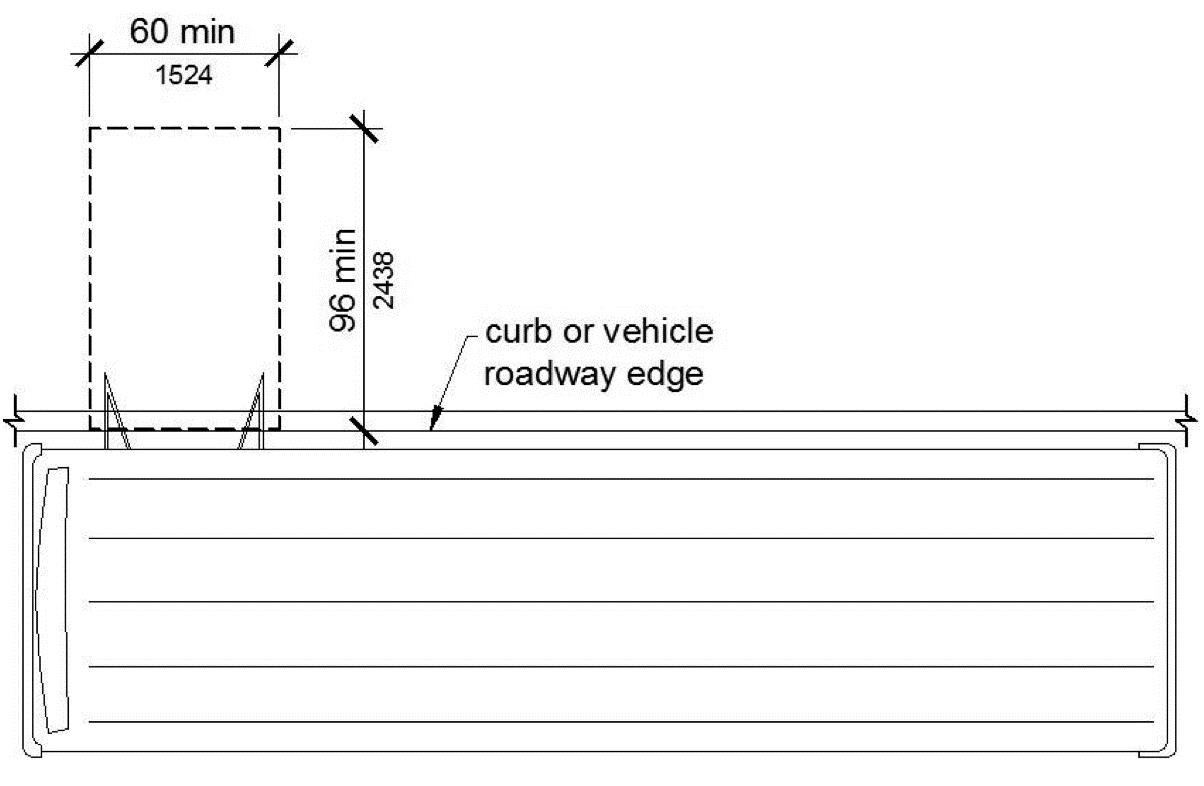
DIMENSIONS OF BUS BOARDING AND ALIGHTING AREAS
11B-810.2.3 Connection.
Bus stop boarding and alighting areas shall be connected to streets, sidewalks, or pedestrian paths by an accessible route complying with Section 11B-402. Newly constructed bus stop boarding and alighting areas shall provide a detectable transition between the boarding/alighting area and the roadway; the detectable transition shall consist of a curb with the face sloped at 35 degrees maximum from vertical or detectable warnings complying with Sections 11B-705.1.1 and 11B-705.1.2.4.
11B-810.2.4 Slope.
Parallel to the roadway, the slope of the bus stop boarding and alighting area shall be the same as the roadway, to the maximum extent practicable. Perpendicular to the roadway, the slope of the bus stop boarding and alighting area shall not be steeper than 1:48.
11B-810.3 Bus shelters.
Bus shelters shall provide a minimum clear floor or ground space complying with Section 11B-305 entirely within the shelter. Bus shelters shall be connected by an accessible route complying with Section 11B-402 to a boarding and alighting area complying with Section 11B-810.2.
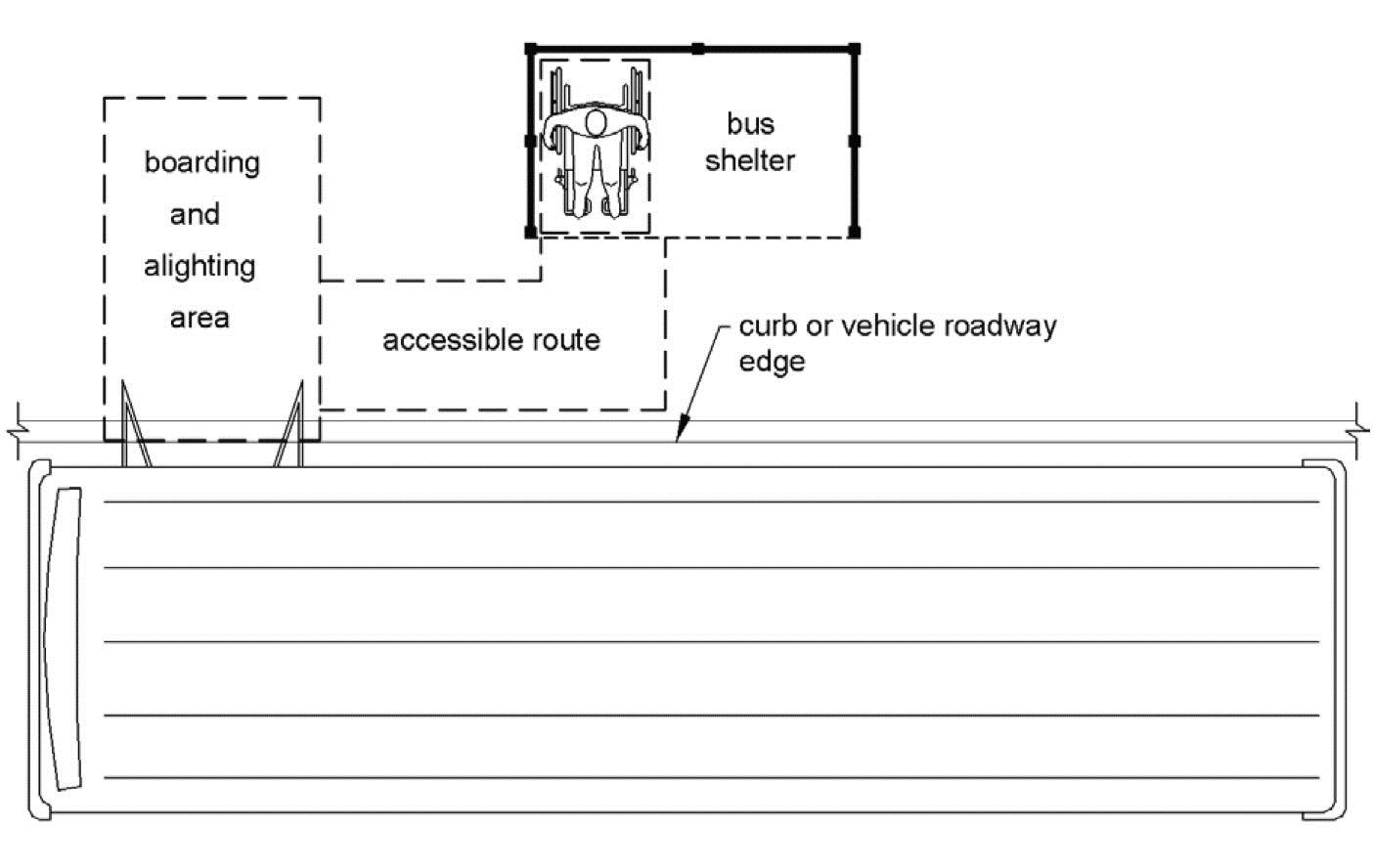
BUS SHELTERS
11B-810.4 Bus signs.
Bus route identification signs shall comply with Sections 11B-703.5.1 _|Finish and Contrast|_ through 11B-703.5.4 _|Character Proportions|_, and Sections 11B-703.5.7 _|Stroke Thickness|_ and 11B- 703.5.8 _|Character Spacing|_. In addition, to the maximum extent practicable, bus route identification signs shall comply with Section 11B-703.5.5 _|Character Height|_.
Exception: Bus schedules, timetables and maps that are posted at the bus stop or bus bay shall not be required to comply.
11B-810.5 Rail Platforms.
Rail platforms shall comply with Section 11B-810.5.
11B-810.5.1 Slope.
Rail platforms shall not exceed a slope of 1:48 in all directions.
Exception: Where platforms serve vehicles operating on existing track or track laid in existing roadway, the slope of the platform parallel to the track shall be permitted to be equal to the slope (grade) of the roadway or existing track.
11B-810.5.2 Detectable warnings.
Platform boarding edges not protected by platform screens or guards shall have detectable warnings complying with Section 11B-705 along the full length of the public use area of the platform.
11B-810.5.3 Platform and vehicle floor coordination.
Station platforms shall be positioned to coordinate with vehicles in accordance with the applicable requirements of 36 CFR Part 1192. Low-level platforms shall be 8 inches (203 mm) minimum above top of rail.
Exception: Where vehicles are boarded from sidewalks or street-level, low-level platforms shall be permitted to be less than 8 inches (203 mm).
U.S. Access Board's Note to Reader:
The Department of Transportation's ADA Standards note permitted alternatives where compliance is not operationally or structurally feasible in light rail, commuter rail, or intercity rail systems:
[ADA Title II - Public Transportation] 810.5.3 Platform and Vehicle Floor Coordination. Station platforms shall be positioned to coordinate with vehicles in accordance with the applicable requirements of 36 CFR part 1192. Low-level platforms shall be 8 inches (205 mm) minimum above top of rail. In light rail, commuter rail, and intercity rail systems where it is not operationally or structurally feasible to meet the horizontal gap or vertical difference requirements of part 1192 or 49 CFR part 38, mini-high platforms, car-borne or platform-mounted lifts, ramps or bridge plates or similarly manually deployed devices, meeting the requirements of 49 CFR part 38, shall suffice.
EXCEPTION: Where vehicles are boarded from sidewalks or street-level, low-level platforms shall be permitted to be less than 8 inches (205 mm).
[2010 ADAS] Advisory 810.5.3 Platform and Vehicle Floor Coordination. The height and position of a platform must be coordinated with the floor of the vehicles it serves to minimize the vertical and horizontal gaps, in accordance with the ADA Accessibility Guidelines for Transportation Vehicles (36 CFR Part 1192). The vehicle guidelines, divided by bus, van, light rail, rapid rail, commuter rail, intercity rail, are available at http://www.access-board.gov/. The preferred alignment is a high platform, level with the vehicle floor. In some cases, the vehicle guidelines permit use of a low platform in conjunction with a lift or ramp. Most such low platforms must have a minimum height of eight inches above the top of the rail. Some vehicles are designed to be boarded from a street or the sidewalk along the street and the exception permits such boarding areas to be less than eight inches high.
11B-810.6 Rail station signs.
Rail station signs shall comply with Section 11B-810.6.
Exception. Signs shall not be required to comply with Sections 11B-810.6.1 and 11B-810.6.2 where audible signs are remotely transmitted to hand-held receivers, or are user or proximity-actuated.
[2010 ADAS] Advisory 810.6 Rail Station Signs Exception. Emerging technologies such as an audible sign system using infrared transmitters and receivers may provide greater accessibility in the transit environment than traditional Braille and raised letter signs. The transmitters are placed on or next to print signs and transmit their information to an infrared receiver that is held by a person. By scanning an area, the person will hear the sign. This means that signs can be placed well out of reach of Braille readers, even on parapet walls and on walls beyond barriers. Additionally, such signs can be used to provide wayfinding information that cannot be efficiently conveyed on Braille signs.
11B-810.6.1 Entrances.
Where signs identify a station or its entrance, at least one sign at each entrance shall comply with Section 11B-703.2 _|Signs; Raised Characters|_ and shall be placed in uniform locations to the maximum extent practicable. Where signs identify a station that has no defined entrance, at least one sign shall comply with Section 11B-703.2 and shall be placed in a central location.
11B-810.6.2 Routes and destinations.
Lists of stations, routes and destinations served by the station which are located on boarding areas, platforms, or mezzanines shall comply with Section 11B-703.5 _|Signs; Visual Characters|_. At least one tactile sign identifying the specific station and complying with Section 11B-703.2 _|Signs; Raised Characters|_ shall be provided on each platform or boarding area. Signs covered by this requirement shall, to the maximum extent practicable, be placed in uniform locations within the system.
Exception: Where sign space is limited, characters shall not be required to exceed 3 inches (76 mm).
[2010 ADAS] Advisory 810.6.2 Routes and Destinations. Route maps are not required to comply with the informational sign requirements in this document.
11B-810.6.3 Station names.
Stations covered by this section shall have identification signs complying with Section 11B-703.5 _|Signs; Visual Characters|_. Signs shall be clearly visible and within the sight lines of standing and sitting passengers from within the vehicle on both sides when not obstructed by another vehicle.
[2010 ADAS] Advisory 810.6.3 Station Names. It is also important to place signs at intervals in the station where passengers in the vehicle will be able to see a sign when the vehicle is either stopped at the station or about to come to a stop in the station. The number of signs necessary may be directly related to the size of the lettering displayed on the sign.
11B-810.7 Public address systems.
Where public address systems convey audible information to the public, the same or equivalent information shall be provided in a visual format.
11B-810.8 Clocks.
Where clocks are provided for use by the public, the clock face shall be uncluttered so that its elements are clearly visible. Hands, numerals and digits shall contrast with the background either light-on-dark or dark-on-light. Where clocks are installed overhead, numerals and digits shall comply with Section 11B-703.5.
11B-810.9 Escalators.
Where provided, escalators shall comply with the sections 6.1.3.5.6 and 6.1.3.6.5 of ASME A17.1 and shall have a clear width of 32 inches (813 mm) minimum.
Exception: Existing escalators in key stations shall not be required to comply with Section 11B-810.9.
11B-810.10 Track crossings.
Where a circulation path serving boarding platforms crosses tracks, it shall comply with Section 11B-402.
Exception: Openings for wheel flanges shall be permitted to be 2½ inches (64 mm) maximum.

FIGURE 11B-810.10 (EXCEPTION)
TRACK CROSSINGS
11B-811.2 Clear floor or ground space.
A clear floor or ground space complying with Section 11B-305 shall be provided.
11B-811.3 Height.
Storage elements shall comply with at least one of the reach ranges specified in Section 11B-308.
11B-811.4 Operable parts.
Operable parts shall comply with Section 11B-309.

User Comments/Questions
Add Comment/Question